Valuation lesson from Zonability Founder, Leigh Budlong!
If a property is not within an incorporated city limit, it is not subject to zoning. The terms “unincorporated” vs. “incorporated” are key. Incorporated cities have their own government, set up ordinances that range from animal control to zoning, and provide services like police, fire, garbage pick up, etc. Each city is different in terms of its zoning and its level of city services. Unincorporated cities use county and/or regional services and private companies.
So how do you know where your property is actually located (and not just using its address)? Request a Zonability Report from your BNT of Texas rep and save an hour (or more) of time researching it yourself!
1. What do I do if the property is in an unincorporated city?
Go to the county to get answers to your questions about development potential. While the county may not have “zoning” to regulate, they do regulate buildings through such things as flood plain, septic, water source, etc.
2. Can you share some examples of unincorporated cities?
Sure! Del Valle, Spicewood, Wells Branch (Austin metro).
Lantana, Rendon, Westminster (Dallas metro).
Canyon Lake, Redwood, Scenic Oaks (San Antonio metro).
Wikipedia lists many of these “unincorporated” cities/places in Texas plus the county. A Zonability report will also share the county name in the “basics” section.
Check out this little flow to see how the process works:
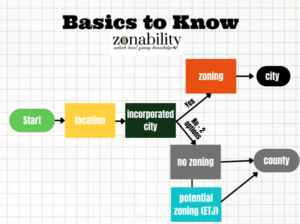
That’s it! You just saved yourself an hour learning this. For those who want more…continue reading.
More Details:
- There are “county” locations and “county with potential to zone” locations. What’s the difference? Incorporated cities earmark locations where they wish to annex. This is called the “ETJ” which stands for Extra Territorial Jurisdiction. Get it? “Jurisdiction” is where they have authority and “Extra” looks to mean “down the road.”
- If the location is simply showing the county, in Zonability, our report will show you the county for our coverage areas. This “county location” with “no city zoning” or “no potential city zoning” is important information you can use to better showcase the location. The next step is to contact the county named, i.e. run a search for “county name” plus key words “development services department.” Each county has a contact person who can discuss what is ok or not (usually this is around floodplain, septic, etc.).
- NEW! We’re adding city boundaries to help give you more information. It is still true we can’t just add an incorporated city to Zonability because not all cities, especially smaller ones, which are often in the path of growth, do not have their zoning data – they have a paper map. However, we are listening to you and understand Granger, Smithville and Weir are popular. Let me show you what we’ve done!
Select Incorporated Cities Without Mapping Data Now Show in Zonability
Here’s a map showing the outline of the incorporated city of Granger, Texas. Any of the parcels in this boundary will return “city limits Granger” in a Zonability Report. But sometimes, as noted, addresses aren’t all that accurate.
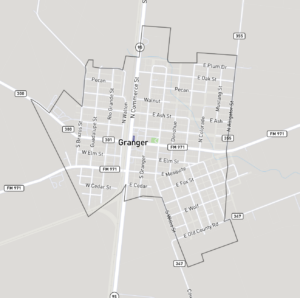
This pink highlight is showing an address that says Granger but is actually outside the boundary line for the incorporated city. What does this mean? It is not subject to Granger zoning!
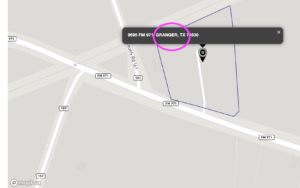
Our report lets you know “outside city limits” and the county is “Williamson.” With these two pieces of information, you can now know your next step is to contact the county (Williamson County Development Services) and ask your questions about how your property might be developable. Scroll down to the end of this post and I’ve added questions that you may want to ask a county contact.
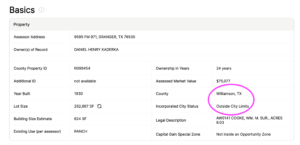
Here’s another example for Weir, Texas. By requesting a Zonability Report from your title rep, you’ll know this property with a Weir address is actually within the city boundary. This means city services are provided and regulations like zoning are enforced.

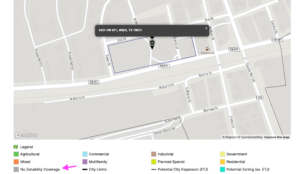

You now know your next step is to contact the city planner in the City of Weir. Run an internet search for “weir, tx city zoning department” and you’ll get to a page like this:
City of Weir Zoning Department
Scroll down to see a contact person:

What to Ask a City Planner? These are just a few ideas/suggestions:
- Please confirm if this location (x) is in your city.
- What is the zoning? (ask if there are any overlays!)
- Where can I find out more about that zoning district?
- This is what I’m trying to do (describe) – what is the process to get approval?
What to Ask a County Development Services Contact? These are just a few ideas/suggestions:
- Please confirm if this location (x) is in your county.
- Is this property in the flood zone?
- What are the regulations regarding subdividing?
- Does the current access meet the requirements for development?
- Where are the closest utilities (if any)?
- What are the requirements around septic and/or water supply?
- This is what I’m trying to do (describe) – what is the process to get approval?
For those who like to dig deeper: This is a handout from the City of Austin regarding their “county – ETJ” area.
This is the legislation cited: Texas Code
Leigh Budlong, Zonability Founder


Recent Comments